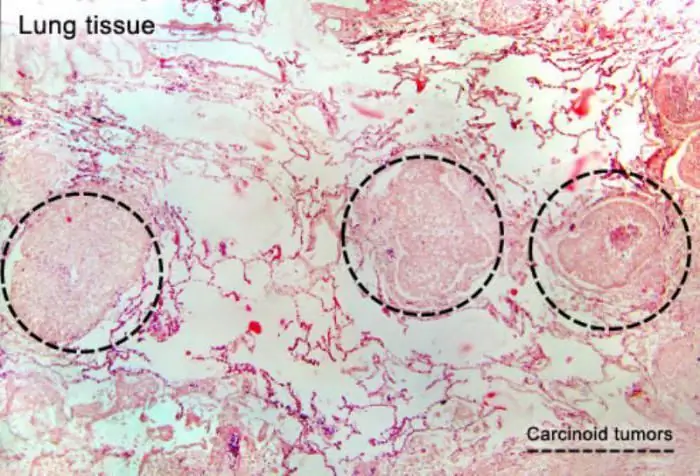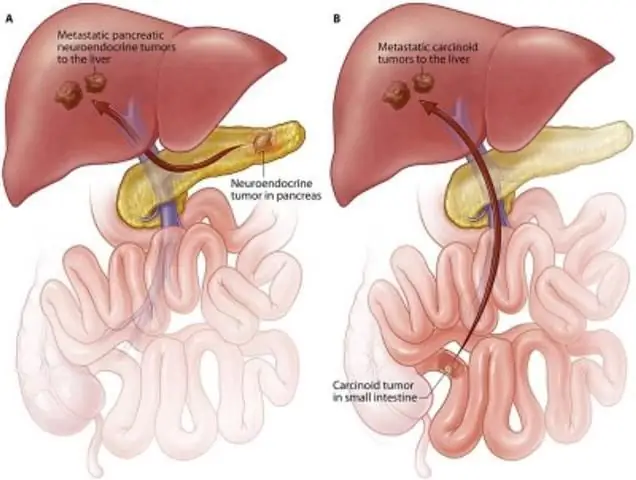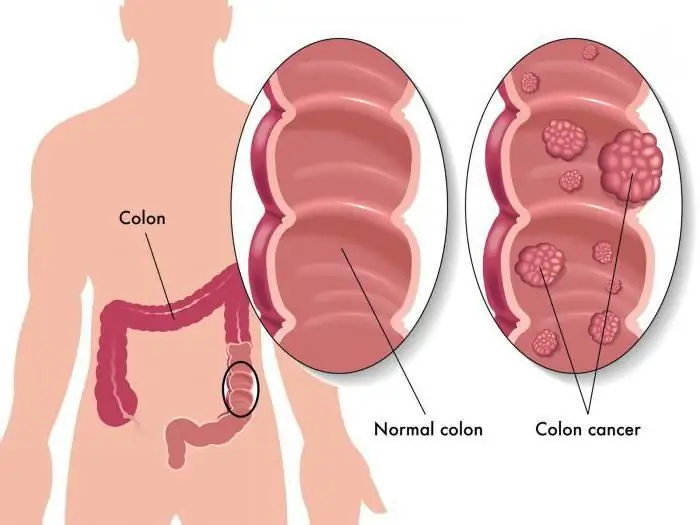- Author Curtis Blomfield [email protected].
- Public 2023-12-16 20:44.
- Last modified 2025-01-23 17:01.
Medical statistics show that the number of oncological diseases is steadily growing. Fatal outcomes are recorded more and more every year. This fact is causing more and more concern and forces doctors to carry out preventive work among the population in order to at least slightly restrain such aggressive expansive growth.
Carcinoid syndrome: what is it?
Carcinoids are the most common tumors from cells of the neuroendocrine system. These cells can be found in any organ and tissue of the body. Their main function is the production of highly active protein substances. About eighty percent of all carcinoids are located in the gastrointestinal tract, followed by the lungs. Much less often, in only five percent of cases, neoplasms are found in other organs and tissues.
Carcinoid syndrome and carcinoid tumor are inseparable from each other, since the syndrome is a set of symptoms that appear against the background of the growth and activity of a malignant tumor. After all, the body reacts to the ingestion of hormones secreted by the tumor into the blood. Intestinal carcinoids can be "silent", that is, they do not manifest themselves in any way until metastases appear and the disease passes into the terminal stage.
Reasons
Researchers do not yet have enough information to understand why carcinoid syndrome and carcinoid tumor develop. Scientists can hypothesize about the etiology of the disease, but everyone agrees that the immune system at some point ceases to recognize mutated cells of the APUD system (an acronym from the first letters of the words "amines", "precursor", "assimilation", "decarboxylation").
One malignant cell is enough to develop a full-fledged neoplasm that will produce hormones and change all biochemical processes in the human body to suit its own needs.
Pathogenesis
How does carcinoid syndrome develop? What is it and how to prevent it? Given that neuroendocrine cells are located throughout the body, and the tumor practically does not give clinical manifestations, doctors are not able to stop this process.
At one moment in the cell there is a "breakage" of DNA, which is incorrectly restored or continues to function with a damaged fragment. This leads to dysfunction of the cell and its uncontrolled division. If the body is he althy, then the immune system will respond to the mutation and get rid of the suspicious element. If this does not happen, then the cell will multiply, create millions of copies of itself and begin to distributetoxic substances and hormones throughout the body.
Often, doctors are unable to locate the tumor despite clinically apparent carcinoid syndrome.
Carcinoma in the lungs

Only in ten percent of cases, a tumor can develop in the respiratory system and, accordingly, a carcinoid syndrome. Signs in the lung will be non-specific, and sometimes they will not be at all. This is due to the relatively small size of the neoplasm and the absence of metastasis. Patients seek help with an already advanced disease and, as a rule, not to an oncologist, but first to a general practitioner. He can long and unsuccessfully treat bronchiolitis, asthma or respiratory failure until he suspects the presence of an oncological process.
Symptoms in this case are atypical:
- rapid, strong heartbeat;
- dyspepsia;
- feeling of heat and rush of blood to the upper half of the body;
- cough, shortness of breath;
- bronchospasm.
With such a set of disorders, it is difficult to suspect a carcinoid. There is no exhaustion, sudden weight loss, reduced immunity, fatigue and other characteristic symptoms of the oncological process.
Tumor of the small intestine
In the small intestine, a tumor and the accompanying carcinoid syndrome are recorded a little more often than in the lungs. His symptoms are very poor. Often only non-specific abdominal pain is present. This is due to the small size of the tumor. Sometimes it can not be detected even during the operation. Often educationnoticed by chance during an x-ray.
Only about ten percent of all tumors of the small intestine of this etiology are the cause of carcinoid syndrome. For the doctor, this means that the process has become malignant and has spread to the liver. Such tumors can cause obstruction of the intestinal lumen and, as a result, intestinal obstruction. The patient comes to the hospital with cramping pains, nausea, vomiting and stool disorders. And the reason for this condition will be found out only on the operating table.
Obstruction can be caused both directly by the size of the tumor, and torsion of the intestine due to the phenomena of fibrosis and inflammation of its mucous membrane. Sometimes scarring disrupts the blood supply to an area of the intestine, leading to necrosis and peritonitis. Any of these conditions are life-threatening and can lead to the death of the patient.
Tumor of the appendix

Tumours of the appendix are rare in themselves. Among them, carcinoids occupy an honorable first place, but practically do not cause carcinoid syndrome. Their signs are extremely scarce. As a rule, these are findings of pathologists after appendectomy. The tumor does not reach even one centimeter in size and behaves very "quietly". The chances that the tumor will appear in some other place after the removal of the appendix are negligible.
But if the detected neoplasm was two centimeters or more in size, then one should be wary of metastasis to local lymph nodes and dissemination of tumor cells to other organs. Ordinary appendectomy in this case will not cope with all the dropouts, and oncologists will have to be involved for complex treatment.
Rectal carcinoid tumor

Another localization in which the carcinoid syndrome is practically not expressed. There are no signs and tumors are found incidentally during diagnostic procedures such as colonoscopy or sigmoidoscopy.
The likelihood of malignancy (malignancy) and the appearance of distant metastases depends on the size of the tumor. If its diameter exceeds two centimeters, then the risk of complications is about eighty percent. If the neoplasm does not even reach one centimeter in diameter, then you can be ninety-eight percent sure that there are no metastases.
Therefore, the approach to treatment in these two cases will be different. A small tumor is usually removed by economical bowel resection, and if there are signs of malignancy, then the entire rectum will be removed, as well as chemotherapy.
Gastral carcinoid
There are three types of gastric carcinoid tumors that cause carcinoid syndrome. Signs of type 1 tumors:
- small sizes (up to 1cm);
- benign course.
Possibly difficult spread of the tumor, when the process captures the entire stomach. They are associated with percynos anemia or chronic gastritis in the patient. The treatment of such tumors is to take somatostatins, inhibition of gastrin production, or resectionstomach.
Tumors of the second type grow slowly, rarely become malignant. They prevail in patients with a genetic disorder such as multiple endocrine neoplasia. Not only the stomach can be affected, but also the epiphysis, thyroid gland, pancreas.
The third type of tumors are large neoplasms that grow in a he althy stomach. They are malignant, penetrate deeply into the wall of the organ and give multiple metastases. May cause perforation and bleeding.
Tumors of the colon
The large intestine is the place where carcinoid syndrome and carcinoid tumor are most commonly diagnosed. A photo of the mucosa during examination of this segment of the intestine shows the presence of large (five centimeters or more) tumors. They metastasize to regional lymph nodes and are almost always malignant.
Oncologists in such cases advise radical surgery with adjuvant and neoadjuvant chemotherapy to achieve the best effect. But the survival prognosis for these patients is still poor.
Carcinoid syndrome: symptoms, photos

Manifestations of carcinoid syndrome depend on what substances the tumor releases. These can be serotonin, bradykinin, histamine or chromogranin A. The most typical signs of the disease are:
- Redness of the face and upper body. It occurs in almost all patients. Accompanied by a local increase in temperature. Seizures occur spontaneouslytriggered by alcohol, stress or exercise. At the same time, tachycardia is observed, pressure drops.
- Stool disorder. Present in ¾ of patients. As a rule, this happens due to irritation of the mucous membrane of the digestive tract, intestinal obstruction.
- Disorders of the heart are inherent in half of the patients. Carcinoid syndrome contributes to the formation of valvular stenosis and causes heart failure.
- Wheezing in the lungs is a consequence of bronchospasm.
- Pain in the abdomen is associated with the appearance of metastases in the liver, intestinal obstruction or tumor growth in other organs.
Carcinoid crisis is a condition characterized by a sudden drop in blood pressure during surgery. Therefore, patients are prescribed somatostatin before such manipulations.
Diagnosis

Can Carcinoid Syndrome Be Detected? Signs, photos, treatment of disparate symptoms does not give a clear clinical picture or visible results. Most often, a tumor is an accidental finding by a surgeon or radiologist. In order to confirm the presence of a tumor, you need to take a biopsy of the affected area and examine the tissue.
You can still use tests to detect elevated levels of hormones, but these data can indicate several diseases, and the doctor has yet to figure out which one he is dealing with. The most specific is the test for the amount of 5-hydroxyindoleacetic acid. If its level is elevated,then the probability of carcinoid is almost 90%.
Chemotherapy

Does it make sense to treat carcinoid syndrome with chemotherapy? Signs, photos of the mucosa during FGDS, a biopsy of regional lymph nodes and changes in hormonal levels can give the doctor an idea of the complications that the presence of a tumor caused in the patient's body. If the prognosis for the patient is unfavorable even if the tumor is removed, then experts advise resorting to chemotherapy.
Most often, doctors use cytostatics to suppress the growth and development of neoplasms. But due to the large number of side effects, this method is recommended to be used only in case of emergency. In addition, its efficiency is only 40%.
Symptomatic treatment
There are uncomfortable sensations that are observed against the background of pathologies such as carcinoid syndrome and carcinoid tumor. Symptoms are usually closely related to the type of hormone that the tumor releases. If it is serotonin, then the patient is prescribed antidepressants. If the main "aggressor" is histamine, then histamine receptor blockers come to the fore in therapy.
Synthetic analogues of somatostatin have been found to reduce symptoms by almost 90%. They suppress the production of several hormones at once and thus secure a strong place for themselves in the treatment of this disease.
Surgical treatment
An important stage of treatment is removal of the tumor from the body, search and resection of metastases, ligation of arteriesliver.
The location and size of the neoplasm, the presence or absence of metastases affects the volume of surgery. Most often, surgeons remove the affected part of the organ and packages of regional lymph nodes. As a rule, this is enough to permanently rid a person of carcinoid. In advanced cases, when radical treatment is not possible, the patient is offered to undergo hepatic artery embolization to remove the symptoms of the disease.
Forecast

What to expect for patients diagnosed with carcinoid syndrome and carcinoid tumor? Hot flashes, heart palpitations and shortness of breath are likely to remain with them for the rest of their lives, but will become less pronounced after treatment.
Medicine knows cases when patients lived for more than ten years after surgery and symptomatic therapy. But on average, their life expectancy is about 5-10 years. Tumors located in the lungs have the worst prognosis, and those in the appendix have the best prognosis.






